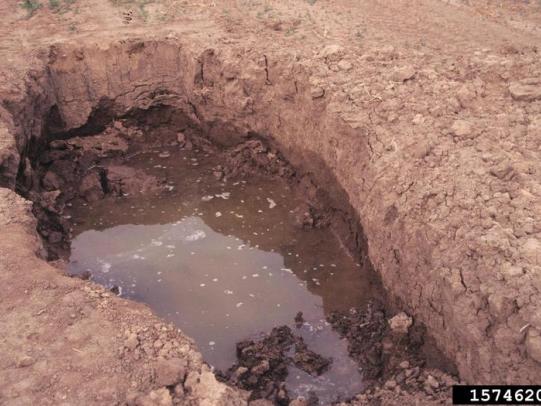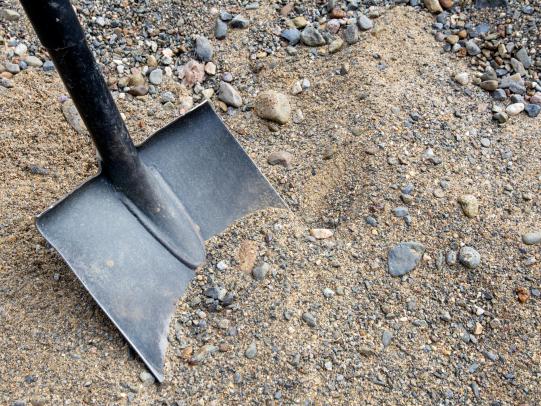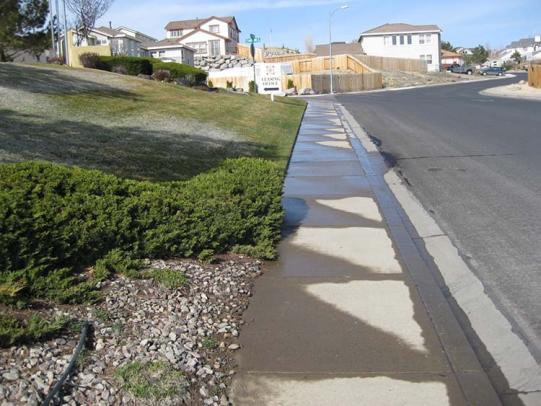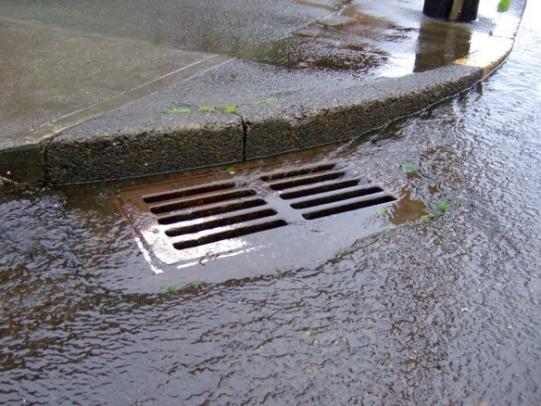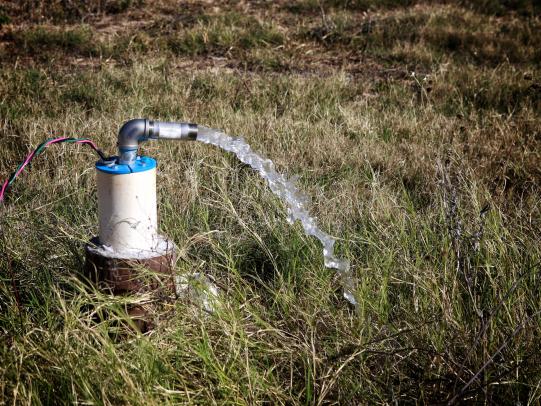UNDERSTANDING PESTICIDE LABELS TO PROTECT Water quality
The photo shows a small stream in an urban area. Pesticide products used on land in your garden and landscape can make their way into waterways. The chemicals in pesticides can harm water quality.
What are pesticides?
Pesticides are products designed to kill rodents, weeds, mosses, insects, plant diseases, slugs, and snails. Household disinfectants such as bleach and ammonia are considered pesticides. Flea-killer products are too.
Jump To
- Groundwater—Understand Pesticide Risks, What Labels Say & What It Means
- Surface Water—Understand Pesticide Risks, What Labels Say & What It Means
- How to Keep Pesticides Out of Your Well
Pesticide risk reduction tips
- In general, don’t apply pesticides when it’s raining, or when the soil is saturated. The product won’t stay put. There are a few homeowner herbicides that may need a light rain or irrigation to be effective. Those situations will be specified on the label.
- Pay attention to the slope of the ground when you apply pesticides. Consider pesticide alternatives when the slope leads down to a body of water.
- Don’t allow granules to rest on hard surfaces. Sweep them into the treatment area to prevent runoff.
- Dispose of leftover pesticides properly; never in a storm drain or gutter. See How to Transport & Dispose of Pesticides.
FOR QUESTIONS ABOUT PESTICIDES
The National Pesticide Information Center (NPIC) can answer questions about pest control chemicals.
1-800-858-7378 or npic@ace.orst.edu
Overview
- Pesticides are applied to many areas of a landscape.
- They may come into contact with water from irrigation or rainfall.
- Pesticides have the potential both to leach into groundwater and to flow into storm drains.
- Storm drains are often directly connected to creeks, rivers, lakes, or the ocean.
- Water in storm drains rarely gets treated. Even when the water goes to a treatment plant, many pesticides pass right through. Wastewater treatment plants aren’t designed to remove them.
- Pesticides that run off from landscapes can have an impact on our drinking water, recreation areas, and aquatic life.
Keys for Success
- Read pesticide labels. Follow the instructions.
- Use information provided on pesticide labels to understand the risks of a product.
- Labels also tell you how to apply pesticide products correctly.
- Look for information about hazards to pollinators in the ENVIRONMENTAL HAZARDS section of the pesticide label.
- Follow the instructions to minimize risks.
- Follow the instructions to maximize benefits.
- Look for the ENVIRONMENTAL HAZARDS section on the product label. It may be inside a booklet or pamphlet.
- Groundwater is a source of drinking water for millions of Americans.
- It’s unfortunately common to find pesticides in groundwater samples. Herbicides are found much more often (in more than 50% of samples) than insecticides (about 8% of samples) (Source: US Geological Survey National Water – Quality Assessment Project ).
How chemicals move in soil and water
- Chemicals move most easily through sandy soils. Clay and organic matter slow them down. If you have sandy soils in your area, chemicals may move to surface water or groundwater.
- Some chemicals bind to soil better than others, which prevents some water contamination. See Pesticide Binding Affinity (NPIC).
- Some chemicals dissolve in water easily, and travel with it. Others do not. Pesticides with high water solubility are more likely to be found in groundwater. See Water Solubility (NPIC).
- Chemicals that take a long time to break down are more likely to reach groundwater. You can look up an herbicide’s half-life. See Pesticide Half-life (NPIC). Look for the active ingredient name. For example, look up the half-life of herbicides such as triclopyr with Herbicide Properties Tool (NPIC).
WHAT THE LABEL SAYS AND WHAT THAT MEANS FOR GROUNDWATER
- Do you want to interpret language that you see on a pesticide label?
- Learn what the information about groundwater on pesticide labels means.
What the Label Says: “This chemical has properties and characteristics associated with chemicals detected in groundwater. This chemical may leach into groundwater if used in areas where soils are permeable, particularly where the water table is shallow.”
What That Means: This means that the chemical, or a major degradate (product of degradation), has a half-life longer than 2 weeks in soil or 30 days in water, and it is not likely to stick to soil particles (Kd less than 5). See Pesticide Binding Affinity (NPIC). Those properties are similar to other pesticides found in groundwater as a result of normal and legal use.
What the Label Says: “This chemical is known to leach through soil into groundwater under certain conditions as a result of label use. This chemical may leach into groundwater if used in areas where soils are permeable, particularly where the water table is shallow.”
What That Means: This means the chemical has actually been detected in groundwater as a result of normal, legal use. The DIRECTIONS FOR USE section of the label will describe specific, required actions to reduce the risk to groundwater.
What if there is no mention of groundwater? It doesn’t mean the product is incapable of reaching groundwater.
Sites with sandy soil and shallow groundwater are especially at risk.
- Look for the ENVIRONMENTAL HAZARDS section on the product label. It may be inside a booklet or pamphlet.
- Surface water is home to wildlife, and provides drinking water for many.
- It’s unfortunately common to find pesticides in streams and rivers.
- A 10-year study by the US Geological Survey states that at least one pesticide was detected in water from all streams studied. They were found throughout most of the year in streams in agricultural areas (97% of the time) and urban areas (97% of the time).
Pesticide storage
- Pesticide storage is more important than you might think. See Storing Pesticides.
- Containers fail over time.
- Inspect pesticides in storage and, when necessary, dispose of them properly. Otherwise, a slow trickle could begin.
For all outdoor, residential consumer products, you will see this language:
- “To protect the environment, do not allow pesticides to enter or run off into storm drains, drainage ditches, gutters, or surface waters.”
- “Applying this product in calm weather when rain is not predicted for the next 24 hours will help to ensure that wind or rain does not blow or wash pesticides off the treatment area.”
WHAT THE LABEL SAYS AND WHAT THAT MEANS FOR SURFACE WATER
- Do you want to interpret language that you see on a pesticide label?
- Learn what the information about surface water on pesticide labels means.
What the Label Says: “This product may impact surface water quality due to runoff of rainwater. This is especially true for poorly draining soils and soils with shallow ground water.”
What That Means: After an environmental assessment, the US EPA required the product manufacturer to add this statement to the product label. This language is usually followed by more specific information about the level of the risk (high or medium) and the duration of the heightened risk (days, weeks, or months).
What the Label Says: “ ... high potential for reaching surface water via runoff.”
What That Means: This chemical is more attracted to water than soil. The Kd was less than 15 when measured. That’s the partitioning coefficient (unitless) for the chemical between water and soil. See Pesticide Binding Affinity (NPIC).
What the Label Says: “ ... medium potential for reaching both surface water and aquatic sediment via runoff.”
What That Means: This chemical is attracted to both water and soil. The Kd was between 15 and 300 when measured. That’s the partitioning coefficient (unitless) for the chemical between water and soil.
What the Label Says: “ ... high potential for reaching aquatic sediment via runoff.”
What That Means: This chemical is attracted to both water and soil. The Kd was more than 300 when measured. That’s the partitioning coefficient (unitless) for the chemical between water and soil.
What the Label Says: “ ... for several days after application.”
What That Means: The chemical has a half-life of less than 8 days. That means at least half of the applied pesticide is expected to break down within 8 days. See Pesticide Half-life (NPIC).
What the Label Says: “ ... for several weeks after application.”
What That Means: The chemical has a half-life of between 8 and 30 days. That means at least half of the applied pesticide is expected to break down within 30 days.
What the Label Says: “ ... for several months or more after application.”
What That Means: The chemical has a half-life of more than 30 days. That means at least half of the applied pesticide is expected to remain for 31 days or more.
What if there is no mention of surface water? This does not mean the product is risk-free.
Take steps to keep any pesticide out of surface water unless the product is labeled for application to water.
CAN PESTICIDES REACH YOUR WELL WATER?
Yes, pesticides can contaminate your well. They are often found in mixtures. The health effects of mixtures are unknown.
In 2005, about 15% of Americans drew their drinking water from private wells. More than 99% of that water came from groundwater.
A study by the US Geological Survey found that contaminants don’t usually show up in well water samples alone. They come in mixtures. There’s not much information about the health effects of low-level mixtures.
- Have your well water tested on a regular basis. The Oregon Health Authority (OHA) has information about testing well water. OHA recommends annual testing.
- Point-of-use devices such as charcoal filters and reverse-osmosis treatments can be used to reduce or remove pesticides in well water.
- When alternatives have failed, select pesticides that do not move easily to groundwater.
- Seek out a professional to inspect your well casing.
- Don’t store chemicals near the wellhead, including pesticides.
Content provided by Kaci Buhl and Weston Miller.
Peer reviewed by OSU Department of Horticulture.
PESTICIDES AND WATER QUALITY REFERENCES
What happens to pesticides released in the environment?
National Pesticide Information Center
Pesticides and Water Resources
National Pesticide Information Center
Drinking Water and Pesticides
National Pesticide Information Center
Well Testing and Regulations
Oregon Health Authority
